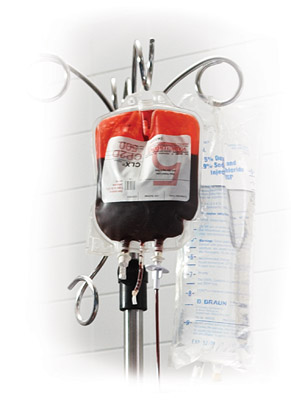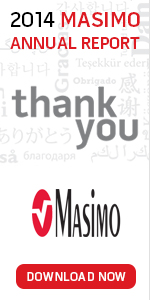| Hemoglobin Home | Transfusion Management | Occult Bleeding Detection | Hemoglobin & Anemia |
| Accuracy & Clinical Application | The Value of Continuously-Trended Hemoglobin | Hemoglobin & PVI | Rainbow Technology Overview |

Transfusion Management Challenges
Growing clinical evidence points to the need for more restrictive blood transfusion management practices to improve patient safety and reduce costs.
- > Blood transfusions are common, with up to 20% of surgical patients and 35% of ICU patients receiving one or more units of blood.1,2
- > Transfusions increase morbidity and mortality.3,4,5
- > As much as 40% increase in 30-day morbidity due to nosocomial infections, sepsis, pneumonia, wound infections and transfusion related injuries.
- > As much as 38% increase in 30-day mortality and 67% increase in 6-month mortality.
- > Blood transfusions are costly, with blood being one of the largest cost centers in a hospital.
- > $500 to $1000 per unit,6 linked to an increase of two or more ICU days per transfusion.7
- > Some blood transfusions are unnecessary, especially when given in stable anemia or when bleeding is perceived but not significant.8 Inappropriate transfusions account for between 9 and 44% of all transfusion costs.9
- > Experts advocate implementing restrictive transfusion practices and use of appropriate indicators for blood transfusion.10,11,12

Opportunity for Enhanced Transfusion Management
Continuous SpHb monitoring may
allow you to:
- > Avoid giving unnecessary transfusions.
- > Initiate more timely transfusions, when appropriate.
- > Decrease costs by more effectively titrating blood.
Continuous monitoring with Masimo SpHb may allow you to initiate timely blood transfusions and avoid giving unnecessary transfusions.
"The current practice of using intermittent, invasive measurements of hemoglobin to help guide transfusion decisions may contribute to unnecessary blood transfusions. Blood transfusion should not simply be based on any particular level of hemoglobin but rather a thorough evaluation of the patient, including whether hemoglobin levels are stable or changing."
Aryeh Shander, MD, Clinical Professor of Anesthesiology, Medicine and Surgery at Mt. Sinai School of Medicine, New York, NY
SpHb could contribute to $93,600 in net annual cost savings in a typical surgical department.
Capgemini Report, 2009: Using Noninvasive Pulse CO-Oximetry to Help Improve Patient Safety, Reduce Costs and Increase Hospital Revenues.
- 1 DeFrances et al. 2006 National Hospital Discharge Survey. Advance Data. 2008;5:1-20.
- 2 Von Ahsehn N et al. Crit Care Med. 1999;12:2630-2639.
- 3 Taylor RW et al. Crit Care Med. 2006;34(9):2302-8.
- 4 Bernard AC et al. Journal of the American College of Surgeons. 2009;208:931-937.
- 5 Surgenor SD et al, for the Northern New England Cardiovascular Disease Study Group. Anesthesia & Analgesia. 2009;108:1741-1746.
- 6 A New Look at Blood Transfusion. Joint Commission Perspectives on Patient Safety. 2007;1:1-12.
- 7 Hill SR et al. Cochrane Database of Systematic Reviews 2000, Issue 1.
- 8 Shander A. Surgery. 2007;142:S20-S25.
- 9 Goodnough LT et al. The American Journal of Medicine. 1993;94:509-514.
- 10 Hebert, et al. Transfusion Requirements in Critical Care Investigators, Canadian Critical Care Trials Group. N Engl J Med. 1999;340:409-17.
- 11 Corwin HL et al. Crit Care Med. 2004;32(1):39-52.
- 12 Taylor RW et al. Crit Care Med. 2006;34(9):2302-8.






